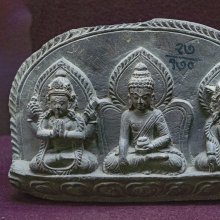Triratna, Tri-ratna: 14 definitions
Introduction:
Triratna means something in Buddhism, Pali, Jainism, Prakrit, Hinduism, Sanskrit, the history of ancient India. If you want to know the exact meaning, history, etymology or English translation of this term then check out the descriptions on this page. Add your comment or reference to a book if you want to contribute to this summary article.
Images (photo gallery)
In Buddhism
Mahayana (major branch of Buddhism)
Source: academia.edu: A Study and Translation of the GaganagañjaparipṛcchāTriratna (त्रिरत्न) refers to the “three jewels”, according to the Gaganagañjaparipṛcchā: the eighth chapter of the Mahāsaṃnipāta (a collection of Mahāyāna Buddhist Sūtras).—Accordingly, “[...] At that time, sixty koṭis of Bodhisattvas, having stood up from the congregation, joined their palms, paid homage to the Lord, and then uttered these verses in one voice: ‘[...] (201) The ignorant among monks, devoting themselves to observances, giving up to practice meditation, will not act in accordance with the three jewels (triratna). (202) Without learning or morality, seeking a profit within the congregation, and exerting themselves all over the time to get gifts, they will be full of thought-constructions with distress. [...]’”.
Source: De Gruyter: A Buddhist Ritual Manual on AgricultureTriratna (त्रिरत्न) refers to the “three jewels”, according to the Vajratuṇḍasamayakalparāja, an ancient Buddhist ritual manual on agriculture from the 5th-century (or earlier), containing various instructions for the Sangha to provide agriculture-related services to laypeople including rain-making, weather control and crop protection.—Accordingly, [as the great Nāga kings said to the Bhagavān]: “[...] O Bhagavān, we will not act with acts of evil morality again. We will make all want of rain and drought disappear. O Bhagavān, we will abide by the promise [the breaking of] which results in a curse. O Bhagavān, we will always guard the Three Jewels (triratna) and the vow of precepts. [...]”.

Mahayana (महायान, mahāyāna) is a major branch of Buddhism focusing on the path of a Bodhisattva (spiritual aspirants/ enlightened beings). Extant literature is vast and primarely composed in the Sanskrit language. There are many sūtras of which some of the earliest are the various Prajñāpāramitā sūtras.
Tibetan Buddhism (Vajrayana or tantric Buddhism)
Source: OSU Press: Cakrasamvara SamadhiTriratna (त्रिरत्न) [=ratnatraya?] refers to the “three jewels”, according to the Guru Mandala Worship (maṇḍalārcana) ritual often performed in combination with the Cakrasaṃvara Samādhi, which refers to the primary pūjā and sādhanā practice of Newah Mahāyāna-Vajrayāna Buddhists in Nepal.—Accordingly, “I bow to all Buddhas, and to the dharma spoken by the Buddha, And to the Sangha perfected in virtue, I bow to the three jewels (ratnatraya). The three jewels are my refuge, I confess in proportion to all my sins, Rejoicing in the merit of the world, turning thought to enlightenment”.

Tibetan Buddhism includes schools such as Nyingma, Kadampa, Kagyu and Gelug. Their primary canon of literature is divided in two broad categories: The Kangyur, which consists of Buddha’s words, and the Tengyur, which includes commentaries from various sources. Esotericism and tantra techniques (vajrayāna) are collected indepently.
General definition (in Buddhism)
Source: Wisdom Library: Dharma-samgraha1) Triratna (त्रिरत्न) refers to the “three treasures” as defined in the Dharma-saṃgraha (section 1):
- Buddha,
- Saṅgha (Saṃgha),
- Dharma.
The Dharma-samgraha (Dharmasangraha) is an extensive glossary of Buddhist technical terms in Sanskrit (e.g., triratna). The work is attributed to Nagarguna who lived around the 2nd century A.D.
2) Triratna (त्रिरत्न, “three jewels”) refers to the second of the “four factors of faith” (śraddhā) as defined in the Dharma-saṃgraha (section 81).
Source: Shambala Publications: GeneralThree Jewels (Skt., triratna) (Pali, tiratna), lit., “three precious ones”; the three essential components of Buddhism: Buddha, dharma, sangha—i.e. the Awakened One, the truth expounded by him, and the followers living in accordance with this truth. Firm faith in the three precious ones is the stage of “stream-entry.” The three precious ones are objects of veneration and are considered “places of refuge.” The Buddhist takes refuge in them by pronouncing the threefold refuge formula, thus acknowledging him- or herself publicly to be a Buddhist. Contemplation of the three precious ones comprises three of the ten contemplations.
In Jainism
General definition (in Jainism)
Source: Knowledge Traditions & Practices of India: Indian Ethics: Individual and Social (jainism)Triratna (त्रिरत्न) refers to “three gems” as defined within Jain ethical conduct (nītiśāstra).—Jainism places great emphasis on three most important things in life, called three gems (triratna).
These triratna are:
- right vision (samyak-dṛṣṭī),
- right knowledge (samyak-jñāna),
- right conduct (samyak-cāritra).
Apart from these, Jain thinkers emphasize the need for reverence (śraddhā).
Source: The University of Sydney: A study of the Twelve ReflectionsTriratna (त्रिरत्न) [=ratnatraya?] refers to the “three jewels”, according to the 11th century Jñānārṇava, a treatise on Jain Yoga in roughly 2200 Sanskrit verses composed by Śubhacandra.—Accordingly, “[com.—Next, some abandon (tyajanti) the Three Jewels (ratnatrayaṃ) [they] gained (prāptam), and he explains (darśayati) exactly that]—And having duly found the path consisting of the Three Jewels (ratnatraya-ātmaka), some whose minds are entirely stupefied by the poison of excessive wrong faith, give up. Some person destroys himself, someone is destroyed by those who have destroyed [themselves] and someone is diverted from the path [to liberation] by the teachings of fierce heretics”.

Jainism is an Indian religion of Dharma whose doctrine revolves around harmlessness (ahimsa) towards every living being. The two major branches (Digambara and Svetambara) of Jainism stimulate self-control (or, shramana, ‘self-reliance’) and spiritual development through a path of peace for the soul to progess to the ultimate goal.
India history and geography
Source: Singhi Jain Series: Ratnaprabha-suri’s Kuvalayamala-katha (history)Triratna (त्रिरत्न) (in the form of darśana, jñāna, caritra) was observed by those pursuing the spiritual life in the Hermitages (or Ashrams) of ancient India, as vividly depicted in the Kathās (narrative poems) such as Uddyotanasūri in his 8th-century Kuvalayamālā (a Prakrit Campū, similar to Kāvya poetry).—Page 87.20-28: Here is a vivid description of the intellectual and spiritual life in the Aśrama of a Jaina Muni. Uddyotanasūri gives a list of twenty-one methods of study and discussions and approaches to the tenets of religion and philosophy, [e.g., observing of Triratna in the form of darśana, jñāna, caritra] [...]. Also see the description of the hermitage of Divākara Mitra described by Bāṇa in the Harṣacarita.

The history of India traces the identification of countries, villages, towns and other regions of India, as well as mythology, zoology, royal dynasties, rulers, tribes, local festivities and traditions and regional languages. Ancient India enjoyed religious freedom and encourages the path of Dharma, a concept common to Buddhism, Hinduism, and Jainism.
Languages of India and abroad
Sanskrit dictionary
Source: Cologne Digital Sanskrit Dictionaries: Edgerton Buddhist Hybrid Sanskrit DictionaryTriratna (त्रिरत्न).—nt. (= ratna-traya, q.v., and see ratna 1), the ‘three jewels’: °nāt Aṣṭasāhasrikā-prajñāpāramitā 179.20 et alibi.
Source: Cologne Digital Sanskrit Dictionaries: Monier-Williams Sanskrit-English DictionaryTriratna (त्रिरत्न):—[=tri-ratna] [from tri] n. the 3 gems: Buddha, the law, and the monkish brotherhood, [Buddhist literature]
[Sanskrit to German]
Sanskrit, also spelled संस्कृतम् (saṃskṛtam), is an ancient language of India commonly seen as the grandmother of the Indo-European language family (even English!). Closely allied with Prakrit and Pali, Sanskrit is more exhaustive in both grammar and terms and has the most extensive collection of literature in the world, greatly surpassing its sister-languages Greek and Latin.
Kannada-English dictionary
Source: Alar: Kannada-English corpusTriratna (ತ್ರಿರತ್ನ):—[noun] (Buddh.) the three gems of Buddhism the Buddha, Dharma (religious righteousness) and religious organisation.
Kannada is a Dravidian language (as opposed to the Indo-European language family) mainly spoken in the southwestern region of India.
Nepali dictionary
Source: unoes: Nepali-English DictionaryTriratna (त्रिरत्न):—n. 1. (Hindu) the three gods: Brahma, Vishnu and Maheshwor; 2. the three metals: gold, silver and copper;
Nepali is the primary language of the Nepalese people counting almost 20 million native speakers. The country of Nepal is situated in the Himalaya mountain range to the north of India.
See also (Relevant definitions)
Starts with: Triratnakula, Triratnatreya, Triratnavamsa.
Ends with: Striratna.
Full-text: Ratnatraya, Anupacchedanata, Ratna, Three treasures, Samgha, Buddha, Observing, Vandana, Four Factors of Faith, Ashtamangala, Balasampad, Study, Cintamani, Pancopacara, Noh, Dharma, Shilanusmriti, Shraddha, Avidya.
Relevant text
Search found 18 books and stories containing Triratna, Tri-ratna; (plurals include: Triratnas, ratnas). You can also click to the full overview containing English textual excerpts. Below are direct links for the most relevant articles:
Amaravati Art in the Context of Andhra Archaeology (by Sreyashi Ray chowdhuri)
Triratna (triple refuge) < [Chapter 3 - Amarāvatī and the Formative Stage of the Buddhist Art]
Resemblance to Gandhāra art < [Chapter 5 - Impact of Amarāvatī Art]
Buddhapāda worship < [Chapter 3 - Amarāvatī and the Formative Stage of the Buddhist Art]
Jainism and Patanjali Yoga (Comparative Study) (by Deepak bagadia)
Part 8.7 - Jain Philosophy < [Chapter 1 - Introduction]
Part 12 - Similarities and differences of both the Philosophies in Nutshell < [Chapter 4 - A Comparative Study]
Part 2 - Fundamental Principles of Jainism (Introduction) < [Chapter 3 - Jain Philosophy and Practice]
Stupas in Orissa (Study) (by Meenakshi Chauley)
Stupa at Sanchi < [Chapter 3]
Probable causes for the decline of Buddhism in Orissa < [Chapter 2]
The gods of northern Buddhism (by Alice Getty)
Sripura (Archaeological Survey) (by Bikash Chandra Pradhan)
Tivaradeva Vihara (SRP-5) < [Chapter 2 - The Architectural Panorama]
Jain Remains of Ancient Bengal (by Shubha Majumder)
Symbol worship in Jainism < [Chapter 6 - Iconographic Study of Jaina Sculptural Remains]
Jainism in Ancient Bengal < [Chapter 3 - Historical Background of Jainism in Ancient Bengal]


